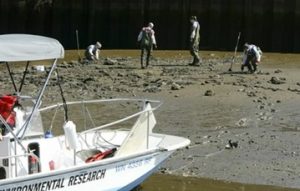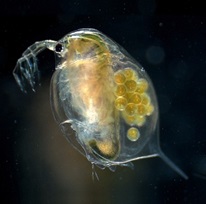Editor’s Note: This is the third installment in a series of posts delving into some of the the chemical pollutants that have contaminated Puget Sound’s fish and wildlife and pose one of the greatest threats to their survival. This is part one of a two-part series, Puget Sound’s Toxic Treadmill, that examines phthalate chemicals found in everything from vinyl shower curtains to shampoo.
This post was written by Dr. Fran Solomon, an environmental biologist who teaches courses and gives seminars for university students, environmental and health care professionals, and the general public about toxic chemicals and how they affect human health and the aquatic environment.
When Valerie Partridge and other scientists at the Washington State Department of Ecology measured levels of toxic chemicals in the sediments of Elliott Bay and the lower Duwamish River in 2007 [1] and Commencement Bay in 2008 [2], they found that levels of several chemicals had decreased since 1998.
That was good news because not only was there hope of returning these waterways to ecological health, the tens of millions of dollars spent to clean up chemical pollution in these waters had been put to good use. But the good news was tempered by evidence that even though these Puget Sound urban bays had undergone cleanup, they were re-contaminated with toxic chemicals called phthalates found in everyday products in our homes.
The specific chemical culprit in the Ecology study was di(2-ethylhexyl) phthalate or DEHP, also known as bis(2-ethylhexyl) phthalate. DEHP is a key ingredient in items such as vinyl flooring and shower curtains. Phthalates aren’t just a problem in Elliott and Commencement Bays; they have been found throughout Puget Sound, showing up in 13 of 18 cleanup sites as well as in other Puget Sound sediments. Phthalates have also been found in salmon as well as in sediment-dwelling invertebrates, shellfish such as crabs, and finfish such as English sole [3].

Thanks to the multitude of sources of these chemicals, it’s almost impossible to keep them from re-contaminating already cleaned up sites like Elliott Bay and the Duwamish. Many everyday consumer products such as vinyl flooring, wallpaper, laundry detergents, children’s toys, cosmetics, shampoo, and nail polish contain phthalates. These chemicals function as plasticizers and as a component of synthetic fragrances. Not being bound tightly to these products, phthalates release easily to the environment [4,5,6].
Unwelcome Guest For Aquatic Life
Phthalates accumulate in freshwater and marine sediments because they get buried as new sediment is piled on top. Phthalates in sediments then, in turn, impact the animals that live in the sediments. Since animals in the sediments take up phthalates faster than they can excrete them, levels of phthalates in the animals will be higher than in the sediments.
Aquatic organisms are continuously exposed to phthalates via water, sediments, and the food that they eat [7,8]. Aquatic organisms in Puget Sound are usually exposed to mixtures of phthalates that can be more harmful than exposure to individual phthalates. For example, some phthalates such as DEHP and di-n-butyl phthalate (DBP) work together to become even more toxic to wildlife together than alone [9].
 Laboratory and field studies have shown that phthalates harm fish and other aquatic organisms. For example, when water fleas (Daphnia magna) (pictured at right) were exposed to an environmentally realistic level of DBP, it affected their ability to reproduce [10]. Phthalates at levels found in the environment can also affect reproduction and development in a wide range of insect, shellfish, and amphibian species. The consequences of disrupted larval development, decreased numbers of animals hatching from eggs, and delayed emergence from eggs are fewer live offspring and smaller populations in subsequent generations [11].
Laboratory and field studies have shown that phthalates harm fish and other aquatic organisms. For example, when water fleas (Daphnia magna) (pictured at right) were exposed to an environmentally realistic level of DBP, it affected their ability to reproduce [10]. Phthalates at levels found in the environment can also affect reproduction and development in a wide range of insect, shellfish, and amphibian species. The consequences of disrupted larval development, decreased numbers of animals hatching from eggs, and delayed emergence from eggs are fewer live offspring and smaller populations in subsequent generations [11].
Research also indicates that phthalates affect fish directly: exposure of rainbow trout (Oncorhynchus mykiss) to an environmentally realistic level of DBP affected their ability to grow normally [12]. Similarly, DEP affected brain, muscle, and liver function, so exposure of fish to low levels in the aquatic environment could impact nerve function and conversion of food to energy [13].
DEHP and other phthalates are endocrine disruptor chemicals; they disrupt hormones, thereby impacting growth and reproduction. So it’s not surprising that their presence in the sediments of Commencement Bay’s Thea Foss Waterway caused survival and reproduction problems for the animals that live there, including tiny mussel larvae and sand fleas that form the base of food webs. Any decrease in their populations or species diversity means that less food is available for other insects, shellfish, and finfish, leading to decreased populations or species diversity in these animals as well [8].
Phthalates and People

Phthalates are found very widely in products used in our homes and on our bodies, so it’s no surprise that they are affecting people as well as Puget Sound residents. The Centers for Disease Control and Prevention found phthalates were present in nearly 100% of 2500 tested Americans [14].
As endocrine disruptor chemicals, phthalates mimic the female sex hormone estrogen and block the male sex hormone testosterone. Dr. Shanna Swan at the University of Rochester found a correlation between higher levels of phthalates in the urine of pregnant women and abnormal reproductive system development in their newborn sons [15]. Phthalate exposure is also linked to decreased testosterone levels in baby boys [16], with reduced sperm quality in adult men [17], and with asthma and skin allergies in children [18]. As hormone disrupting chemicals, phthalates don’t appear to discriminate between water fleas and people.
Photo Attributions
Duwamish River Sampling courtesy of the Duwamish River Cleanup Coalition
Water flea courtesy of Flicker user dullhunk
Notes
- Partridge, V., S Weakland, E Long, K Welch, M Dutch, and M Jones, Urban Waters Initiative, 2007 – Sediment Quality in Elliott Bay. 2009, Environmental Assessment Program, Washington State Department of Ecology: Olympia
- Partridge, V., S Weakland, E Long, K Welch, M Dutch, and M Jones, Urban Waters Initiative 2008 – Sediment Quality in Commencement Bay. 2010, Environmental Assessment Program, Washington State Department of Ecology: Olympia.
- Sediment Phthalates Work Group, Summary of Findings and Recommendations. 2007, Prepared by City of Tacoma, City of Seattle, King County, Washington State Department of Ecology, and U.S. Environmental Protection Agency
- Agency for Toxic Substances and Disease Registry (ATSDR), Di(2-Ethylhexyl) Phthalate (DEHP) Tox FAQs. Update. 2002, Public Health Service, U.S. Department of Health and Human Services: Atlanta.
- Agency for Toxic Substances and Disease Registry (ATSDR), Toxicological Profile for Di(2-Ethylhexyl) Phthalate (DEHP). 1998, Public Health Service, U.S. Department of Health and Human Services: Atlanta.
- Washington State Department of Ecology, Toxics Cleanup Program, Sediment Management Unit website: www.ecy.wa.gov/programs/tcp/smu/phthalates
- Trim, H., BJ Cummings, E Hulsizer, and K Flint, Phthalates – the next phosphate?, Proceedings of the 2005 Puget Sound Georgia Basin Research Conference, Seattle.
- City of Tacoma, Floyd/Snider, and Grette Associates, Utilities Year 3 Operations, Maintenance, and Monitoring Plan (OMMP) Report, Thea Foss and Wheeler-Osgood Waterways Remediation Project. 2007, Prepared for U.S. Environmental Protection Agency: Tacoma.
- Schierow, L. and MM Lee, Phthalates in plastics and possible human health effects, CRS Report RL 34572. 2008, National Council for Science and the Environment: Washington, D.C.
- McCarthy, JF and DK Whitmore, Chronic toxicity of di-N-butyl and di-N-octyl phthalate to Daphnia magna and the fathead minnow. Environmental Toxicology and Chemistry, 1985. 4(2): pp. 167-169.
- Oehlmann, J., U Schulte-Oehlmann, W Kloas, O Jagnytsch, I Lutz, KO Kusk, L Wollenberger, EM Santos, GC Paull, KJW Van Look, and CR Tyler, A critical analysis of the biological impacts of plasticizers on wildlife. Philosophical Transactions of the Royal Society B, 2009. 364: pp.2047-2062.
- Rhodes, JE, WJ Adams, GR. Buddinger, KA Robillard, and JW Gorsuch, Chronic toxicity of 14 phthalate esters to Daphnia magna and rainbow trout (Oncorhynchus mykiss). Environmental Toxicology and Chemistry, 1995. 14(11): pp. 1967-1976.
- Ghorpade, N., V Mehta, M Khare, P Sinkar, S Krishnan, and RC Vaman, Toxicity study of diethyl phthalate on freshwater fish Cirrhinia mrigala., Ecotoxicology and Environmental Safety, 2002. 53(2): pp. 255-258.
- Centers for Disease Control, CDC’s Third National Report on Human Exposure to Environmental Chemicals: Spotlight on Phthalates. 2002, CDC: Atlanta.
- Swan, SH, KM Main, F Liu, SL Stewart, RL Kruse, AM Calafat, CS Mao, JB Redmon, CL Ternand, S Sullivan, and JL Teague, Decrease in anogenital distance among male infants with prenatal phthalate exposure. Environmental Health Perspectives, 2005. 113(8): pp. 1056-1061.
- Main, KM, GK Mortensen, MM Kaleva, KA Boisen, IN Damgaard, M Chellakooty, IM Schmidt, AM Suomi, HE Virtanen, JH Petersen, AM Andersson, J Toppari, and NE Skakkebaek, Human breast milk contamination with phthalates and alterations of endogenous reproductive hormones in infants three months of age. Environmental Health Perspectives, 2006. 114(2): pp. 270-276.
- Duty, SM, RM Ackerman, A.M. Calafat, and R. Hauser (2005). “Personal Care Product Use Predicts Urinary Concentrations of Some Phthalate Monoesters,” Environmental Health Perspectives 113(11): pp. 1530-1535.
- Bornehag, CG, J Sundell, CJ Weschler, T Sigsgaard, B Lundgren, and M Hasselgren, The association between asthma and allergic symptoms in children and phthalates in house dust: a nested case-control study. Environmental Health Perspectives, 2004b. 112: pp. 1393-1397.




